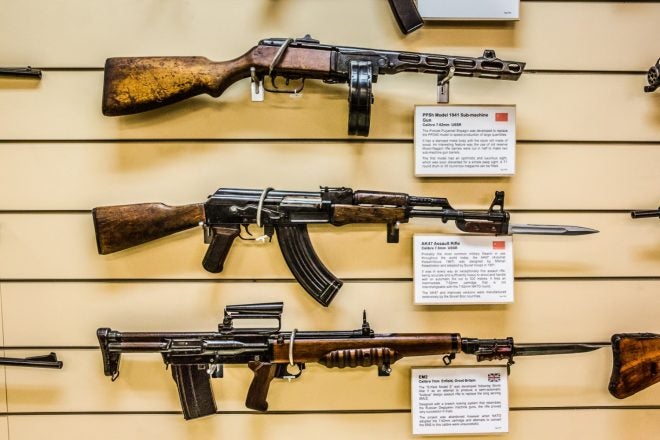Back in March, I reported on a new regulation that would turn firearms held in Australian museums into “metal blobs.” The impact this could have on the collection at the Lithgow Small Arms Factory Museum was at the heart of the discussion.
On August 30th, the New South Wales government released an amendment to their 2017 Firearms Regulation regarding the handling of museum firearm permits. The amendment allows a Police Commissioner to grant a museum an exemption from having its pistols and prohibited firearms permanently deactivated … but only under “certain circumstances.”
The good folks at the Lithgow Small Arms Factory Museum did not sit idly by between March and August. They argued for the reinstatement of temporary deactivation (removal of firing pins) combined with designated security systems, which is how they had been previously operating.

Display at the Lithgow Small Arms Factory Museum.
For a time, it even seemed like things might take a turn for the better. In June, Lithgow Small Arms Factory Museum issued this brief update statement: “We believe our collective efforts have had an impact and our concerns are being listened to by the NSW Government. Our recent meeting with the Police Minister was quite productive.”
Unfortunately, that optimism was short-lived; so, what does this mean for the arms museums and their collections? First of all, permanent deactivation is still the ultimate goal of the New South Wales government. The only way to avoid this kind of destruction of material culture is to beg a police commissioner for an exemption.
Even if a museum decides to petition for an exemption, the new amendment doesn’t provide clear instructions on what they would need to do to actually prove that their collection is worthy of an exemption. Moreover, just because an exemption was approved once, doesn’t mean that it would be reauthorized when it came time for renewal. This would allow the commissioner to “revoke the museum exemption if satisfied the exemption is no longer reasonable in the circumstances.” It also states that the exemption can be “amended or revoked at any time” if the commissioner wants to change the conditions under which the exemption was previously approved.

All slated to be turned into “metal blobs.”
What, exactly, does that mean? Good question; no one seems to know for sure as isn’t delineated in the amendment. The definition of “reasonable,” “conditions,” and “circumstance” is not stated, and that is certainly troubling. If you’d like to read the entirety of the amendment, you can find it here.
While the Lithgow Small Arms Factory Museum has been at the center of this controversy, they are far from being the only museum that will be impacted. There are as many as 63 museum permits in New South Wales, and many of them would not be able to meet the new definition of a museum and/or the strict security requirements necessary for an exemption. As a result, those facilities would have their permits revoked and their guns would have to be rendered permanently inoperable, effectively destroying their cultural significance and negating the purpose of the museum in the first place.
The stakes are high for all of the museums in New South Wales, but the impact felt at the Lithgow Small Arms Factory Museum would be devastating. It’s estimated that 70% of their collection would be destroyed if the police commissioner denied their petition for an exemption. Prototypes, experimental projects, serial number one guns, and countless other irreplaceable pieces of Australian arms history would simply cease to exist.
In case that seems a bit dramatic to you, here’s a refresher regarding what would have to be done in order to meet the definition of “permanently inoperable” – “inserting a steel rod down the barrel of the firearm and welding the muzzle and chamber, welding the barrel to the receiver, removing the firing pin and welding the hole, removing all internal springs, welding internal components and welding the bolt, magazine, external hammer and trigger in a fixed position.” If that doesn’t accurately describe a “metal blob,” then I don’t know what does.

Rows and rows of rifles (Courtesy Brendan Maunder)
In a statement released on September 6, the Lithgow Small Arms Factory Museum expressed their frustrations with the new amendment. “Organisations like ours are therefore penalised for the incompetence of others. There is enormous ignorance as to what constitutes a firearms museum and this is a very sad fact which lawmakers are happy to ignore, but in so doing are not doing their job.”
The statement sums up the entire issue quite nicely: “We are saddled with a second-rate system, where it will get down to an individual who, in all likelihood knows little about how museums operate, making a call on a museum’s future.”
Despite this setback, the Lithgow Small Arms Factory Museum is not giving up. They say they will continue their fight for reform, standing firm in their belief that “museum accountability is far superior and a better practice than regulatory paperwork.”
 Your Privacy Choices
Your Privacy Choices
